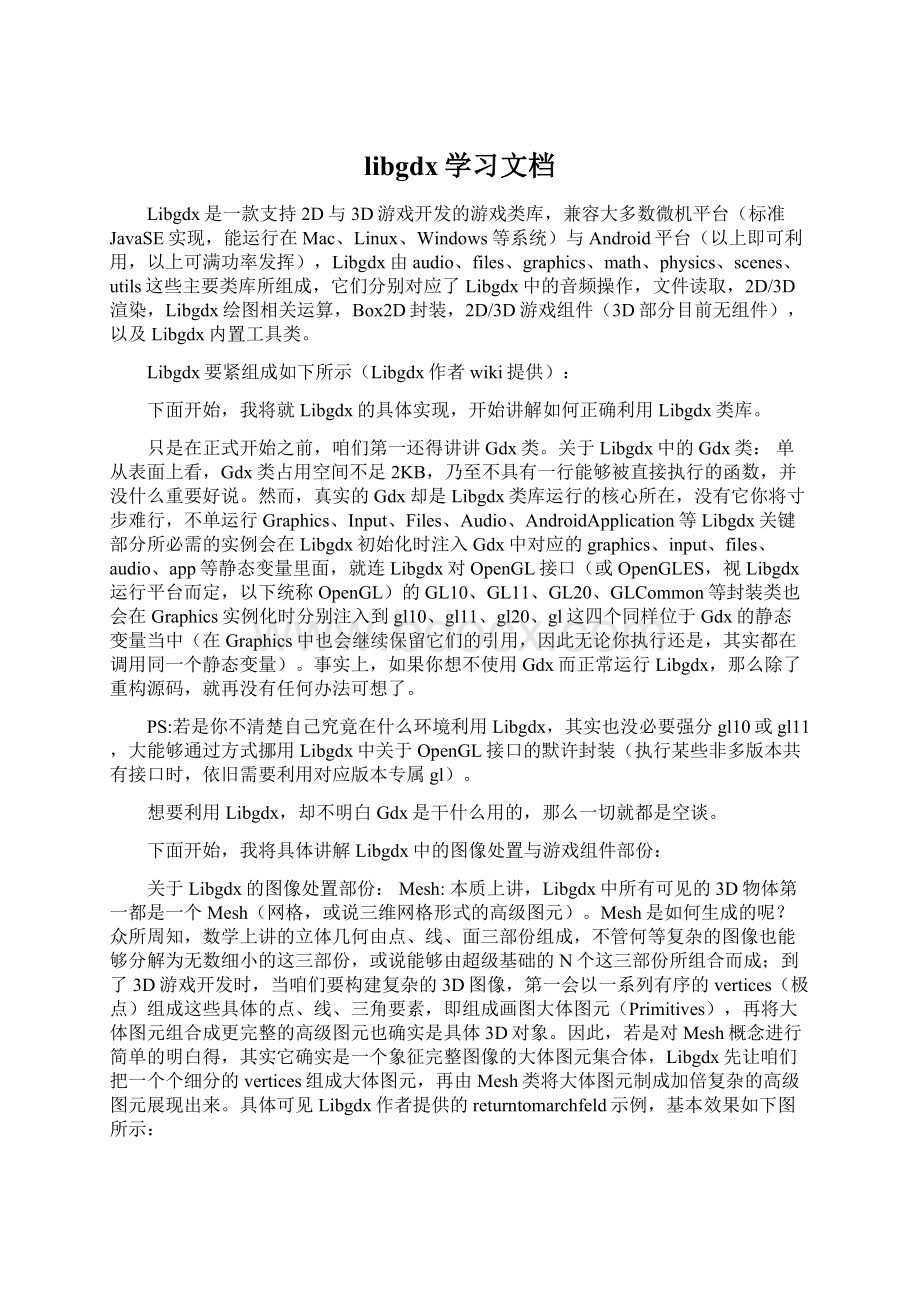libgdx学习文档.docx
《libgdx学习文档.docx》由会员分享,可在线阅读,更多相关《libgdx学习文档.docx(17页珍藏版)》请在冰豆网上搜索。

libgdx学习文档
Libgdx是一款支持2D与3D游戏开发的游戏类库,兼容大多数微机平台(标准JavaSE实现,能运行在Mac、Linux、Windows等系统)与Android平台(以上即可利用,以上可满功率发挥),Libgdx由audio、files、graphics、math、physics、scenes、utils这些主要类库所组成,它们分别对应了Libgdx中的音频操作,文件读取,2D/3D渲染,Libgdx绘图相关运算,Box2D封装,2D/3D游戏组件(3D部分目前无组件),以及Libgdx内置工具类。
Libgdx要紧组成如下所示(Libgdx作者wiki提供):
下面开始,我将就Libgdx的具体实现,开始讲解如何正确利用Libgdx类库。
只是在正式开始之前,咱们第一还得讲讲Gdx类。
关于Libgdx中的Gdx类:
单从表面上看,Gdx类占用空间不足2KB,乃至不具有一行能够被直接执行的函数,并没什么重要好说。
然而,真实的Gdx却是Libgdx类库运行的核心所在,没有它你将寸步难行,不单运行Graphics、Input、Files、Audio、AndroidApplication等Libgdx关键部分所必需的实例会在Libgdx初始化时注入Gdx中对应的graphics、input、files、audio、app等静态变量里面,就连Libgdx对OpenGL接口(或OpenGLES,视Libgdx运行平台而定,以下统称OpenGL)的GL10、GL11、GL20、GLCommon等封装类也会在Graphics实例化时分别注入到gl10、gl11、gl20、gl这四个同样位于Gdx的静态变量当中(在Graphics中也会继续保留它们的引用,因此无论你执行还是,其实都在调用同一个静态变量)。
事实上,如果你想不使用Gdx而正常运行Libgdx,那么除了重构源码,就再没有任何办法可想了。
PS:
若是你不清楚自己究竟在什么环境利用Libgdx,其实也没必要强分gl10或gl11,大能够通过方式挪用Libgdx中关于OpenGL接口的默许封装(执行某些非多版本共有接口时,依旧需要利用对应版本专属gl)。
想要利用Libgdx,却不明白Gdx是干什么用的,那么一切就都是空谈。
下面开始,我将具体讲解Libgdx中的图像处置与游戏组件部份:
关于Libgdx的图像处置部份:
Mesh:
本质上讲,Libgdx中所有可见的3D物体第一都是一个Mesh(网格,或说三维网格形式的高级图元)。
Mesh是如何生成的呢?
众所周知,数学上讲的立体几何由点、线、面三部份组成,不管何等复杂的图像也能够分解为无数细小的这三部份,或说能够由超级基础的N个这三部份所组合而成;到了3D游戏开发时,当咱们要构建复杂的3D图像,第一会以一系列有序的vertices(极点)组成这些具体的点、线、三角要素,即组成画图大体图元(Primitives),再将大体图元组合成更完整的高级图元也确实是具体3D对象。
因此,若是对Mesh概念进行简单的明白得,其实它确实是一个象征完整图像的大体图元集合体,Libgdx先让咱们把一个个细分的vertices组成大体图元,再由Mesh类将大体图元制成加倍复杂的高级图元展现出来。
具体可见Libgdx作者提供的returntomarchfeld示例,基本效果如下图所示:
(勿看FPS,一切信真机)PS:
若是对此类熟悉不足,能够去玩玩模拟人一辈子,下个修改器尝试编辑角色或物品造型后就懂了…… PS指postscript(备注,又可说明为附言、跋文)的缩写Texture:
Libgdx所提供的游戏纹理用类,其实质可明白得为保留在显存中的Image,它以贴图的方式通过OpenGL将图片显示到游戏界面之上。
Libgdx的纹理能够直接从指定文件途径加载,也能够通过它提供的Pixmap类凭空创建(它的Texture(intwidth,intheight,Formatformat)构造内部直接挪用了Pixmap,不是必需在外部生成Pixmap后注入)。
另外在加载Texture时,个人建议通过Libgdx提供的函数挪用,该方式内部提供了Texture缓存治理,能够幸免无心义的资源重复加载。
另外,Texture通常会与TextureRegion类配套利用,利用TextureRegion包装Texture后,再利用SpriteBatch进行绘制,能够很方便的修订Texture为咱们需要的显示范围。
还有,Libgdx中Sprite类为TextureRegion子类,因此能够将Sprite看成TextureRegion来利用,只是Sprite类比TextureRegion有所扩展。
只是Libgdx的SpriteCache类并无继承Sprite或TextureRegion,因此起不到TextureRegion的作用,只能构建一组静态贴图集合算了,特此说明。
1.MainMainMainnternal(""), false);
2. }
3. publicvoid render(){
1. Main4a2a-0.5f0.5f0.0f0.0f-0.5f-0.5f0.0f1.0f0.5f-0.5f1.0f1.0f0.5f0.5f1.0f0.0fetHeight());
2.
3.
4. ();
5.
6. ();
1. Main-0.5f-0.5f0.5f-0.5f0.5f0.5f4a4a2a0f1f0f0.2f0.2f0.2fetWidth(),
2. ().getHeight(), false,
3. true);
4. ();
5. }
6. publicvoid resize(int width, int height){
7. }
8. publicvoid resume(){
9. }
10. }
11. publicvoid onCreate(Bundlebundle){
12. (bundle);
1. Mainet()){
1. Main(Sequence.$(ScaleTo.$(1.1f, 1.1f, 0.3f),
2. ScaleTo.$(1f,1f, 0.3f))));
3. (img);
4. }
5. publicvoid render(){
6.
7.
8. ();
9. }
10. publicvoid dispose(){
11. ();
12. ();
13. }
14. publicvoid pause(){
15. }
16. publicvoid resize(int width, int height){
17. }
18. publicvoid resume(){
19. }
20. }
21. publicvoid onCreate(Bundlebundle){
22. (bundle);
2月1日2020年1月28日7aDidyounotice,however,thatthetriangleswecreatedappearstretched?
Letsstartwithanexamplethatwillmakethisissueclear.
CreatingaSquare
Createanewlibgdxdesktopprojectnamed projection-viewport-camera.Createaclasscalled ProjectionViewportCamera thatimplementsApplicationListener andputitinthepackage Forfullinstructiononhowtosetupalibgdxdesktop(andAndroid)project,lookatthe tutorial.Unlikeinthattutorial,we'regoingtoshowasquareinsteadofarectangle.Here'sthecodefor ProjectionViewportCamera:
packageimportimportimportimportimportimportimportpublicclassProjectionViewportCameraimplementsApplicationListener{ privateMeshsquarePartOne; privateMeshsquarePartTwo; @Override publicvoidcreate(){ if(squarePartOne==null){ squarePartOne=newMesh(true,3,3, newVertexAttribute,3,"a_position"), newVertexAttribute,4,"a_color")); (newfloat[]{ -,-,0,(128,0,0,255), ,-,0,(192,0,0,255), -,,0,(192,0,0,255)}); (newshort[]{0,1,2}); } if(squarePartTwo==null){ squarePartTwo=newMesh(true,3,3, newVertexAttribute,3,"a_position"), newVertexAttribute,4,"a_color")); (newfloat[]{ ,-,0,(192,0,0,255), -,,0,(192,0,0,255), ,,0,(255,0,0,255)}); (newshort[]{0,1,2}); } } @Override publicvoiddispose(){} @Override publicvoidpause(){} @Override publicvoidrender(){ ,0,3); ,0,3); } @Override publicvoidresize(intwidth,intheight){} @Override publicvoidresume(){}}
It'sverysimilartotheclassdescribedintheMyFirstTriangleTutorialexceptthatithastwotrianglesinsteadofone.Thetwotrianglesarepositionedtoformasquare,withcornersatposition(x,y)coordinates,,,,,,and,.Whenyourunthedesktopappitshouldlooklikethis:
Obviously,eventhoughwespecifiedthecoordinatesofasquare,theresultingshapeturnedouttobeawiderectangle.Beforetacklingthisissue,Iwilldigressforamomentandofferarenderingoptimzationforthissquare.
Thetwotriangleseachhaveavertexat,andavertexat,.Wecaneliminatetheduplicationofverticesatidenticalcoordinatesbyimplementingthesquareusing .Usingtrianglestripsallowthetwotrianglestoshareverticesandthereforeusememorymoreefficiently(checkout forabetterillustration).Here'sthenewimplementation:
packageimportimportimportimportimportimportimportpublicclassProjectionViewportCameraimplementsApplicationListener{ privateMeshsquareMesh; @Override publicvoidcreate(){ if(squareMesh==null){ squareMesh=newMesh(true,4,4, newVertexAttribute,3,"a_position"), newVertexAttribute,4,"a_color")); (newfloat[]{ -,-,0,(128,0,0,255), ,-,0,(192,0,0,255), -,,0,(192,0,0,255), ,,0,(255,0,0,255)}); (newshort[]{0,1,2,3});16 } } @Override publicvoiddispose(){} @Override publicvoidpause(){} @Override publicvoidrender(){ ,0,4); } @Override publicvoidresize(intwidth,intheight){} @Override publicvoidresume(){}}
Thetwotriangleshavebeencombinedinasinglemeshwithfourverticesandfourindices.Inside render(),wespecifythatthesquarewasdefinedusingtrianglestrips.Fewerverticesarenecessaryandthecodeissimplertoo.
Viewport
Backtotheissueofthestretchedsquare.Bydefaulttheviewportrevealsarectangularareawithaleftedgeatx=-1,rightedgeatx=1,topedgeaty=1,andbottomedgeaty=-1.Here'sapictureofwhatablankarealikethatwouldlooklikeifweweretocreatemockup:
Whenweplaceoutredsquareontothatarea,theresultlookslikethis:
However,theviewportitselfiswiderthanasquare.Inordertofilluptheextraspaceonthesides,theareaisstretched.Imagineapainterstretchingasquarecanvastofitarectangularframe.Theresultlookslikewhatweseeinthe tutorial:
Camera
Tocorrectthiseffect,weallowtheviewporttorenderanareathatisrectangularinsteadofsquare.Theshapeofthisareawillmatchtheshapeofviewport,sortoflikeapainterchoosingacanvassizebasedonthepictureframe'ssize.Toaccomplishthis,weusethe Camera class,inthisacaseasubclasscalled OrthographicCamera.The Camera classallowsustochangetheareashownbytheviewport.Here'sthenewcode:
packageimportimportimportimportimportimportimportimportpublicclassProjectionViewportCameraimplementsApplicationListener{ privateMeshsquareMesh; privateOrthographicCameracamera; @Override publicvoidcreate(){ if(squareMesh==null){ squareMesh=newMesh(true,4,4, newVertexAttribute,3,"a_position"), newVertexAttribute,4,"a_color")); (newfloat[]{ -,-,0,(128,0,0,255), ,-,0,(192,0,0,255), -,,0,(192,0,0,255), ,,0,(255,0,0,255)}); (newshort[]{0,1,2,3}); } } @Override publicvoiddispose(){} @Override publicvoidpause(){} @Override publicvoidrender(){ (); ; ,0,4); } @Override publicvoidresize(intwidth,intheight){ floataspectRatio=(float)width/(float)height; camera=newOrthographicCamera(2f*aspectRatio,2f); } @Override publicvoidresume(){}}
In resize(),weconstructanewinstanceof OrthographicCamera,specifiyingtheareawewanttodisplay.Inthisexample,wetellthecameratodisplayanareatwounitstall,withawidththatisdeterminedbytheshapeoftheviewport.In render(),wecallsimplycall update() andapply() onthe Camera instance.Here'showitlookswhenweruntheapp:
Thedesktopviewportinourtutorialshavebeen480pixelswideand320pixelshigh.Thesearethenumbersarepassedinto resize() whentheappl